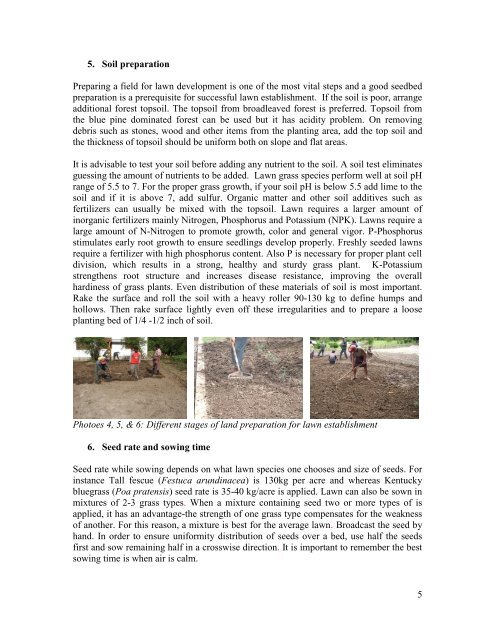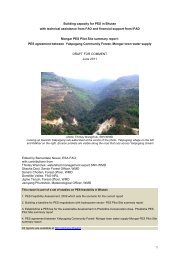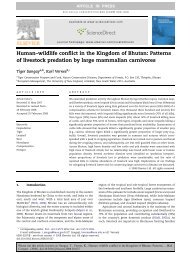A guide to Lawn Grass Development for temperate - DoFPS
A guide to Lawn Grass Development for temperate - DoFPS
A guide to Lawn Grass Development for temperate - DoFPS
You also want an ePaper? Increase the reach of your titles
YUMPU automatically turns print PDFs into web optimized ePapers that Google loves.
5. Soil preparation<br />
Preparing a field <strong>for</strong> lawn development is one of the most vital steps and a good seedbed<br />
preparation is a prerequisite <strong>for</strong> successful lawn establishment. If the soil is poor, arrange<br />
additional <strong>for</strong>est <strong>to</strong>psoil. The <strong>to</strong>psoil from broadleaved <strong>for</strong>est is preferred. Topsoil from<br />
the blue pine dominated <strong>for</strong>est can be used but it has acidity problem. On removing<br />
debris such as s<strong>to</strong>nes, wood and other items from the planting area, add the <strong>to</strong>p soil and<br />
the thickness of <strong>to</strong>psoil should be uni<strong>for</strong>m both on slope and flat areas.<br />
It is advisable <strong>to</strong> test your soil be<strong>for</strong>e adding any nutrient <strong>to</strong> the soil. A soil test eliminates<br />
guessing the amount of nutrients <strong>to</strong> be added. <strong>Lawn</strong> grass species per<strong>for</strong>m well at soil pH<br />
range of 5.5 <strong>to</strong> 7. For the proper grass growth, if your soil pH is below 5.5 add lime <strong>to</strong> the<br />
soil and if it is above 7, add sulfur. Organic matter and other soil additives such as<br />
fertilizers can usually be mixed with the <strong>to</strong>psoil. <strong>Lawn</strong> requires a larger amount of<br />
inorganic fertilizers mainly Nitrogen, Phosphorus and Potassium (NPK). <strong>Lawn</strong>s require a<br />
large amount of N-Nitrogen <strong>to</strong> promote growth, color and general vigor. P-Phosphorus<br />
stimulates early root growth <strong>to</strong> ensure seedlings develop properly. Freshly seeded lawns<br />
require a fertilizer with high phosphorus content. Also P is necessary <strong>for</strong> proper plant cell<br />
division, which results in a strong, healthy and sturdy grass plant. K-Potassium<br />
strengthens root structure and increases disease resistance, improving the overall<br />
hardiness of grass plants. Even distribution of these materials of soil is most important.<br />
Rake the surface and roll the soil with a heavy roller 90-130 kg <strong>to</strong> define humps and<br />
hollows. Then rake surface lightly even off these irregularities and <strong>to</strong> prepare a loose<br />
planting bed of 1/4 -1/2 inch of soil.<br />
Pho<strong>to</strong>es 4, 5, & 6: Different stages of land preparation <strong>for</strong> lawn establishment<br />
6. Seed rate and sowing time<br />
Seed rate while sowing depends on what lawn species one chooses and size of seeds. For<br />
instance Tall fescue (Festuca arundinacea) is 130kg per acre and whereas Kentucky<br />
bluegrass (Poa pratensis) seed rate is 35-40 kg/acre is applied. <strong>Lawn</strong> can also be sown in<br />
mixtures of 2-3 grass types. When a mixture containing seed two or more types of is<br />
applied, it has an advantage-the strength of one grass type compensates <strong>for</strong> the weakness<br />
of another. For this reason, a mixture is best <strong>for</strong> the average lawn. Broadcast the seed by<br />
hand. In order <strong>to</strong> ensure uni<strong>for</strong>mity distribution of seeds over a bed, use half the seeds<br />
first and sow remaining half in a crosswise direction. It is important <strong>to</strong> remember the best<br />
sowing time is when air is calm.<br />
5





